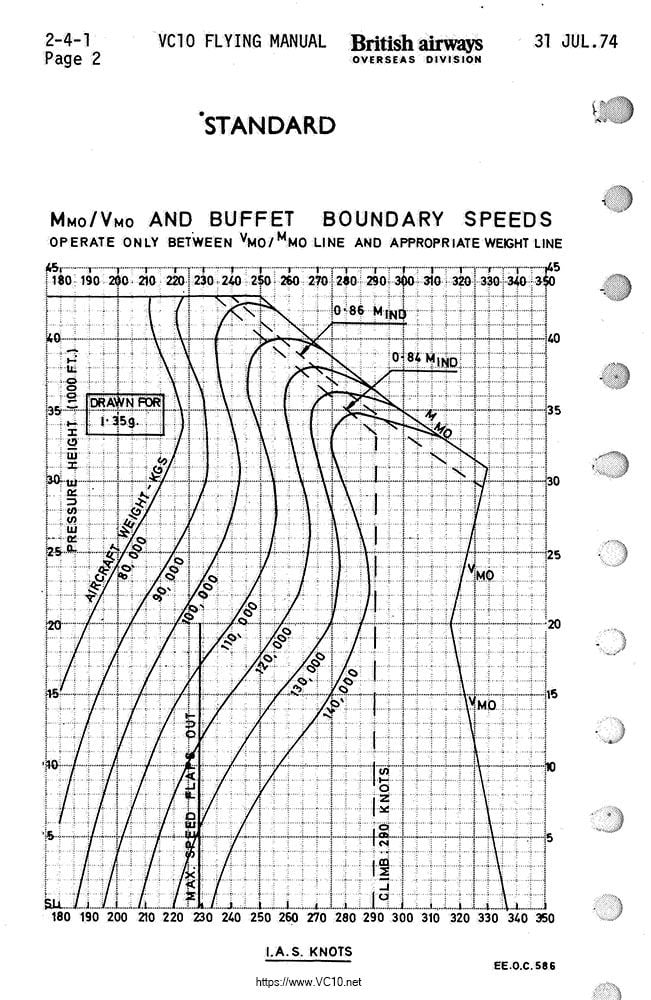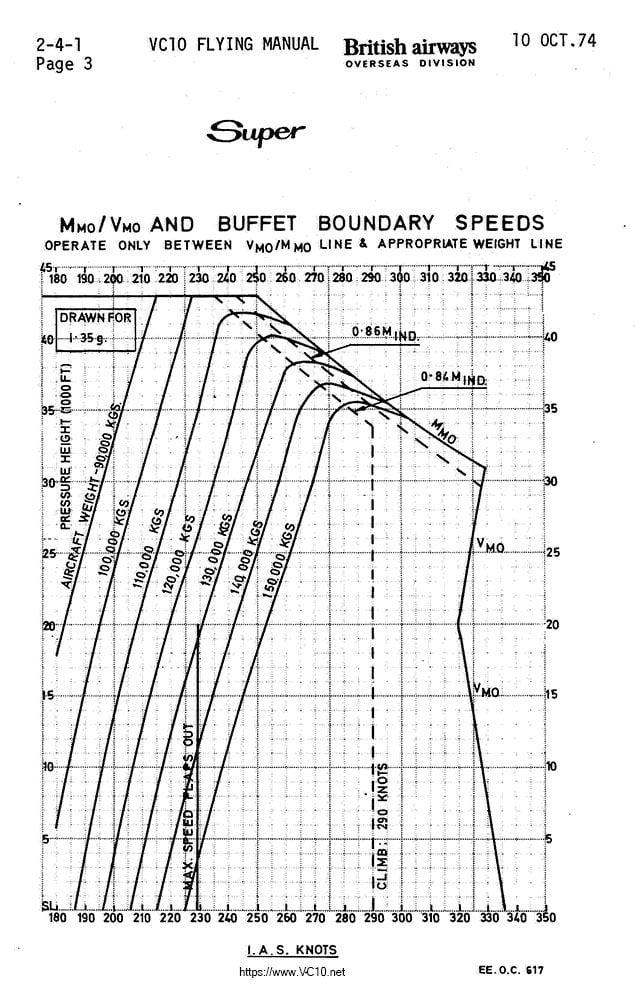VC10 increasing Vmo above 20000 feet
Thread Starter
VC10 increasing Vmo above 20000 feet
https://www.pprune.org/tech-log/629038-vc10-increasing-vmo-above-20000-feet.htm
Can one of our experienced VC10 pilots educate me?
Can one of our experienced VC10 pilots educate me?
I had a look at the Tech Log thread here: VC10 increasing Vmo above 20000 feet
I guess you found the BCal Sales Brochure on my site? Or was it a different document?
I don't have the answer for you, but I do have these graphs that illustrate the issue. In addition, I'd also like to know the reason for the changing Vmo.


I guess you found the BCal Sales Brochure on my site? Or was it a different document?

I don't have the answer for you, but I do have these graphs that illustrate the issue. In addition, I'd also like to know the reason for the changing Vmo.


Last edited by Jhieminga; 22nd Jan 2020 at 08:00. Reason: Dodgy typing
I asked an ex-VC10 flight engineer who was involved with the test flying. His response:
You will notice that the slope of the high speed part of the diagram is closely related to true air speed, and that is the clue.
The force on the air being driven upward by the leading edge of the wing is directly related to the air density and the acceleration that is being applied to that mass of air so that it can pass over the wing.
As the true air speed increases the acceleration required of the mass of air increases and it is eventually reluctant to follow the wing shape.
The reducing Vmo shows how this comes into effect.
However with increasing altitude, above approximately 20,000ft, the density of the air reduces to the extent that the mass of the air to be accelerated also reduces such that its reluctance to move is reduced.
It will therefore follow the shape of the wing more willingly.
The graph shows rigid straight lines but in truth there is a slight curve, particularly at about 20,000ft.
There is a slight difference between the standard and super high speed buffet but it was decided to leave the diagram the same and therefore not have to modify the path of the Vmo pointer in the ASI.
The top end of the diagram is fairly conventional and shows when shock waves are likely to significantly disrupt the air flow.
Just a reminder that the diagram is drawn, as required by the the Air Registration Board (ARB), for a situation of the aircraft manoeuvring and pulling a force of 1.35G. (A bank angle of about 42 deg.)
You can see how close the 290kt climb speed comes to the low speed buffet boundary. I normally advised my pilots to climb a bit faster at high weight, normally I suggested 300kt.
In straight and level flight, with no disruption, the aircraft could fly well outside the low and high limits, of the diagram as we proved during certification flying, but not approved for in service.
Going too fast produced a bit of a rumble.
I hope that helps to explain both side of the diagram.
The force on the air being driven upward by the leading edge of the wing is directly related to the air density and the acceleration that is being applied to that mass of air so that it can pass over the wing.
As the true air speed increases the acceleration required of the mass of air increases and it is eventually reluctant to follow the wing shape.
The reducing Vmo shows how this comes into effect.
However with increasing altitude, above approximately 20,000ft, the density of the air reduces to the extent that the mass of the air to be accelerated also reduces such that its reluctance to move is reduced.
It will therefore follow the shape of the wing more willingly.
The graph shows rigid straight lines but in truth there is a slight curve, particularly at about 20,000ft.
There is a slight difference between the standard and super high speed buffet but it was decided to leave the diagram the same and therefore not have to modify the path of the Vmo pointer in the ASI.
The top end of the diagram is fairly conventional and shows when shock waves are likely to significantly disrupt the air flow.
Just a reminder that the diagram is drawn, as required by the the Air Registration Board (ARB), for a situation of the aircraft manoeuvring and pulling a force of 1.35G. (A bank angle of about 42 deg.)
You can see how close the 290kt climb speed comes to the low speed buffet boundary. I normally advised my pilots to climb a bit faster at high weight, normally I suggested 300kt.
In straight and level flight, with no disruption, the aircraft could fly well outside the low and high limits, of the diagram as we proved during certification flying, but not approved for in service.
Going too fast produced a bit of a rumble.
I hope that helps to explain both side of the diagram.
In straight and level flight, with no disruption, the aircraft could fly well outside the low and high limits, of the diagram as we proved during certification flying, but not approved for in service.
But graphs I have seen for other jet aircraft transport types do not have that pronounced kink at 20,000ft. What was so different about the VC10?
And as for being outside the boundaries of the graph, remember it is drawn for 1.35g, I've been up to a little over 46,000ft, just between the high speed and low speed buffets in smooth air. Ease the stick forward - a gentle high speed rumble; ease it back a little - the onset of low speed buffet. This was with a certain ex-617 Squadron training captain.
And as for being outside the boundaries of the graph, remember it is drawn for 1.35g, I've been up to a little over 46,000ft, just between the high speed and low speed buffets in smooth air. Ease the stick forward - a gentle high speed rumble; ease it back a little - the onset of low speed buffet. This was with a certain ex-617 Squadron training captain.
The VC10 was the first supercritical wing to enter service on an airliner, as far as I know. With that in mind, a strangely shaped diagram doesn't surprise me as they must have encountered a few new things along the way. We also know that the wing leading edge extension on the Super (and all but the BOAC Standards) wing was a compromise between redesigning a whole wing structure and an economical solution. So aerodynamically, the wing was not ideal. Later supercritical wings will have learned from this process, most likely sorted it out at an earlier stage and didn't have to deal with four hungry engines behind that wing center section either.
Just a bit of guesswork on my end, but it fits....
Just a bit of guesswork on my end, but it fits....




